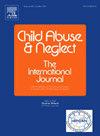儿童虐待和精神病理在机构和监禁的青少年在尼日利亚:一个潜在的阶级分析方法
IF 3.4
2区 心理学
Q1 FAMILY STUDIES
引用次数: 0
摘要
儿童虐待(CM)在寄宿或监禁的青少年中很普遍,是行为健康障碍的一个危险因素。在低收入国家进行的任何研究都没有对这些高危青少年的CM类型和不良后果进行实证比较。目的本研究的目的是确定cm的概况及其与尼日利亚高危青少年行为健康问题的关系。参与者和环境:参与者包括青少年拘留所的青少年(N = 102)和居住场所的青少年(N = 103),年龄在10-17岁之间。方法采用两步潜类分析(LCA),对CM的有效自述量表数据进行分析,以确定虐待的不同特征及其与行为健康问题和PTSD症状的有效自述量表的关联。结果发现三个潜在类别:(1)目击暴力和忽视类别(N = 20,10 %);身心虐待类(N = 41, 20%);多重虐待类(N = 144,70 %)。与目睹暴力和忽视类相比,身体和情感虐待类(第2类)和多重虐待类(第3类)报告的其他逆境(即父母/监护人监禁和贫困)和更严重的愤怒和易怒症状、创伤经历、思维障碍和躯体抱怨的比例明显更高。多重虐待组的创伤后应激障碍(PTSD)症状比其他两组更严重。而目睹暴力忽视班的焦虑抑郁症状较其他班严重,自杀意念较多重虐待班严重。结论:研究结果强调了在被监禁和收容的青少年中,暴露于多种形式的虐待(即多重受害)的作用,并强调了解决目睹暴力或经历忽视的青少年的抑郁、焦虑和自杀意念的必要性。将创伤后应激障碍和创伤后应激障碍筛查纳入弱势青年心理健康服务,可以通过识别和纠正不同的多重受害模式和创伤后应激障碍的不良影响,促进他们的康复和治疗。本文章由计算机程序翻译,如有差异,请以英文原文为准。
Child maltreatment and psychopathology among institutionalized and incarcerated adolescents in Nigeria: A latent class analysis approach
Background
Child maltreatment (CM) is prevalent among residentially-placed or incarcerated adolescents and is a risk factor for behavioral health disorders. No study conducted in a low-income country has empirically compared the types of CM and adverse outcomes experienced by these high-risk adolescents.
Objective
The purpose of this study was to identify profiles of CM-and their association with behavioral health problems among at-risk adolescents in Nigeria.
Participants and Setting: Participants comprised adolescents in juvenile detention facilities (N = 102) and adolescents in residential placements (N = 103) aged 10–17 years old.
Methods
A two-step latent class analysis (LCA) was applied with data from validated self-report measures of CM to identify distinct profiles of maltreatment and their association with validated self-report measures of behavioral health problems and PTSD symptoms.
Results
Three latent classes were identified: (1) witnessing violence and neglect class (N = 20,10 %); physical and emotional abuse class (N = 41,20 %); and multiple maltreatment class (N = 144, 70 %). The physical and emotional abuse class (class 2) and the multiple maltreatment class (class 3) reported significantly higher rates of other adversities (i.e., parent/guardian incarceration and poverty) and more severe angry and irritable symptoms, traumatic experiences, thought disturbances, and somatic complaints when compared to the witnessing violence and neglect class. The multiple maltreatment class had more severe post-traumatic stress disorder (PTSD) symptoms than the other two classes. The witnessing violence and neglect class, however, had more severe anxiety depression symptoms than the other classes and more severe suicidal ideation than the multiple maltreatment class.
Conclusion
The findings underscore the role of exposure to multiple forms of maltreatment (i.e., poly-victimization) among incarcerated and institutionalized adolescents, and highlight the need to address depression, anxiety, and suicidal ideation in youths who have witnessed violence or experienced neglect. Integrating CM and PTSD screening into mental health service for these vulnerable youth could enhance their rehabilitation and treatment by identifying and remediating the adverse effects of different patterns of poly-victimization and CM.
求助全文
通过发布文献求助,成功后即可免费获取论文全文。
去求助
来源期刊

Child Abuse & Neglect
Multiple-
CiteScore
7.40
自引率
10.40%
发文量
397
期刊介绍:
Official Publication of the International Society for Prevention of Child Abuse and Neglect. Child Abuse & Neglect The International Journal, provides an international, multidisciplinary forum on all aspects of child abuse and neglect, with special emphasis on prevention and treatment; the scope extends further to all those aspects of life which either favor or hinder child development. While contributions will primarily be from the fields of psychology, psychiatry, social work, medicine, nursing, law enforcement, legislature, education, and anthropology, the Journal encourages the concerned lay individual and child-oriented advocate organizations to contribute.
 求助内容:
求助内容: 应助结果提醒方式:
应助结果提醒方式:


